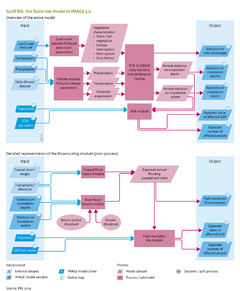Flood risks: Difference between revisions
Jump to navigation
Jump to search
No edit summary |
No edit summary |
||
| Line 10: | Line 10: | ||
Bierkens and Van Beek, 2009; | Bierkens and Van Beek, 2009; | ||
Hinkel and Klein, 2009; | Hinkel and Klein, 2009; | ||
|InputVar=Land cover, land use - grid; Population - grid; GDP per capita - grid; | |InputVar=Land cover, land use - grid; Population - grid; GDP per capita - grid; Land cover, land use - grid; | ||
|OutputVar=Expected nr of affected people - grid; Expected value of affected GDP - grid; Statistics of flooded depth - grid; Statistics of flooded fraction - grid; Statistics of river discharge - grid; | |OutputVar=Expected nr of affected people - grid; Expected value of affected GDP - grid; Statistics of flooded depth - grid; Statistics of flooded fraction - grid; Statistics of river discharge - grid; | ||
|Parameter=Topography - grid; Coastal storm surges; Flood statistics; Historical climate dataset - grid; | |Parameter=Topography - grid; Coastal storm surges; Flood statistics; Historical climate dataset - grid; | ||
Revision as of 14:39, 3 February 2014
| Component is implemented in: |
|
| Related IMAGE components |
| Models/Databases |
| Key publications |
| References |
Key policy issues
- How will future flood risk change as a result of socio-economic changes and climate change?
- What would be the impact of floods, in terms of damage and victims, and where are the hot spots?
- What would be suitable adaptation strategies and investment options related to flood risk?
